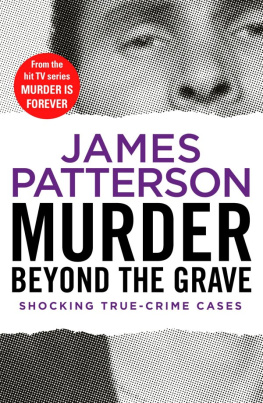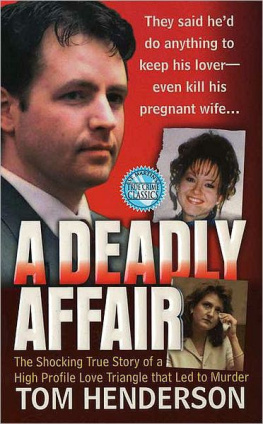
Published by Zebra Press
an imprint of Penguin Random House South Africa (Pty) Ltd
Reg. No. 1953/000441/07
The Estuaries No. 4, Oxbow Crescent, Century Avenue, Century City, 7441
PO Box 1144, Cape Town, 8000, South Africa
www.zebrapress.co.za
First published 2015
Publication Penguin Random House 2015
Text Jana van der Merwe 2015
Cover photographs Grave photo: Charl Devenish/ Volksblad /Foto24;
Michael van Eck: Facebook; Chan van Heerden: Theo Jeptha/ Volksblad /Foto24;
Maartens van der Merwe: Charl Devenish/ Volksblad /Foto24
Knife: WO Ernst du Ru/SAPS/Local Criminal Record Centre Welkom
All rights reserved. No part of this publication may be reproduced, stored in a retrieval system or transmitted, in any form or by any means, electronic, mechanical, photocopying, recording or otherwise, without the prior written permission of the copyright owners.
PUBLISHER: Marlene Fryer
MANAGING EDITOR: Janet Bartlet
EDITOR: Ronel Richter-Herbert
PROOFREADER: Bronwen Leak
COVER DESIGNER: Monique Cleghorn
TEXT DESIGNER: Ryan Africa
TYPESETTER: Tessa Fortuin
ISBN 978 1 77022 776 7 (print)
ISBN 978 1 77022 777 4 (ePub)
ISBN 978 1 77022 778 1 (PDF)
In loving memory of Michael Ignatius van Eck 14 August 19873 April 2011
Contents
Authors note
It was shortly before midnight on Sunday 3 April 2011 when I learnt of the story Volksblad was to exclusively publish on Mondays front page. In a state of utter disbelief, I went to bed thinking of the news South Africa was to wake up to the next morning. The details of the murder committed in the Welkom cemetery unfolded over the next days, weeks and months, and each revelation was more shocking than the last. The memory of what had happened lingered in my mind long after the killers were convicted.
In 2013 my former colleague at Rapport , Jacques Steenkamp, was in the process of writing his first, now bestselling, true-crime book when I told him of my idea to write a book about the crime committed in Welkom. He urged me to contact his publisher, Marlene Fryer, at Penguin Random House, and the rest is history. Thank you to my initial managing editor, Ronel Richter-Herbert, who believed in this project so much that she became my editor, and to my eventual managing editor, Janet Bartlet, for all her help and support throughout the process.
Writing and, moreover, researching this book has been an emotional and taxing journey, and telling this once-in-a-lifetime story would not have been possible without Candice Botha, a former classmate from the University of KwaZulu-Natal, who edited the first draft of this book. I cant thank you enough.
To all the major role players in this book who shared their stories while they would rather forget: Lieutenant Ogies Nel, Advocate Johan de Nysschen, Warrant Officer Eben van Zyl, Warrant Officer Lynda Steyn, Danie Krgel, Warrant Officer Fanie du Plessis, Warrant Officer Ernst de Ru, Professor Dap Louw, Doctor Sonja Loots and Brigadier Gerard Labuschagne my admiration for you transcends words.
Thank you also to Ephraim Morolong and Roy Verster for your assistance. Roy is the only person in the book for whom a pseudonym is used. The reason for this is because he has suffered tremendous abuse and victimisation for being a friend of Maartens van der Merwe. The community and people on social media accused Roy of being involved in the murder and for having known what would happen. He did not know and he was not involved.
To my colleagues and friends Claudi and Annami Mailovich, Charles Visser, Felix Dlangamandla, Mary-Ann Palmer, Pauli van Wyk, Vania van der Heever and the rest of my colleagues and former colleagues at Volksblad , Beeld and Rapport you know who you are your every word of encouragement got me here.
Words cannot express the love and gratitude I have for my family for their unconditional love and support throughout my life and career my mother, Georgina, brothers Johann and Richart, Roxane, Nada, Keke and my father JJK van der Merwe. A special thanks also to my partner Willie Venter and his family, Dawie and Marita, Lelanie and Carl.
I pray for healing for the Van Eck family, Michaels parents and sisters who loved him and who were robbed of him so tragically.
My wish is that everyone reading this book will get a glimpse into the psyches of the two serial-killers-in-the-making who were stopped before they could kill again and gain insight into what was, in the opinion of many, one of the worst and most perplexing murder cases ever reported on in South Africas crime history.
JANA VAN DER MERWE
JOHANNESBURG
OCTOBER 2015
1
Discovering the murder scene
In the silence of his office, the graveyard supervisor startled as the cellphone sitting on his orderly wooden desk trembled unexpectedly.
Ephraim Morolong frowned as he looked at the name flashing on the screen, the piercing sound disturbing the calm. He had arrived just a moment before with the workmen to take on a hard day of overtime labour at the Welkom cemetery instead of attending church that Sunday morning.
Morolong, an upright middle-aged man with short salt-and-pepper hair, had reported for work at 8 a.m. sharp to get a grip on the long grass that had grown lush after the summer rains. The mornings weather had been pleasant and it promised to be a sunny day. The weather bureau predicted more rain for that week, however, and for Ephraim this would only mean more work for his already short-staffed team. He was in on a Sunday himself hoping to get ahead on some urgent paperwork before handing in his quarterly report on Monday.
Surrounded by flat, grassy, rural landscape, maize crops, cattle farms and mine dumps, the Welkom cemetery is isolated from the mining city of Welkom, which is set in the Goldfields of central South Africa, approximately 150 kilometres north of Bloemfontein, the Free State provinces capital city. The citys main burial ground lies at the foot of one of these mine dumps, less than seven kilometres outside of the city and on the R30 towards the town of Odendaalsrus.
This massive terrain, with at least 10 000 graves, had begun to look increasingly downtrodden and unkempt over the years, the ever-increasing number of graves having become overwhelming.
Ephraim had armed the small group of men and women, clad in dark-green overalls and hats, with picks and shovels to get on with the days work before he put on the kettle and settled down at his desk with his paperwork.
Ephraim, you have to come see this, said the frantic voice in Sesotho at the other end of the phone line.
Although locals would regularly tell one another that the cemetery is a popular hangout for illegal miners, known as zama-zamas , who perpetrate crime in the area, Ephraim had never had any problems.
Apart from all the burials he oversees every day of the week, only once had he come across a dead body that was not brought there to be buried a father and husband who had come to the graveyard one night to put an end to his life and financial woes with a single bullet to the head. Ephraim found his ice-cold body the next morning between the entrance and the parking lot. Another time, he had come across a young woman with her head thrown back on the verge of unconsciousness in her small vehicle, her breathing shallow. Ephraim hastily disconnected the hosepipe pumping its toxic and suffocating fumes from the exhaust and jerked the other end out of her car window. Smashing the glass to unlock the door, he dragged her unconscious body to safety. She survived. The unsung hero continued his work.
Next page












